Accepting any new work that comes your way might seem like a great idea for growth. But in reality, you’re setting yourself up for a margin-eroding nightmare.
Taking on bad-fit work burns out teams, derails strategic priorities, and damages client relationships.
Instead, use the F.A.S.T. framework to evaluate prospects before you commit.
Here’s how it works:
What is the F.A.S.T. framework?
F.A.S.T. is a simple four-part checklist that helps agencies and other professional service firms decide which client projects are worth pursuing.
Each letter covers a key area:
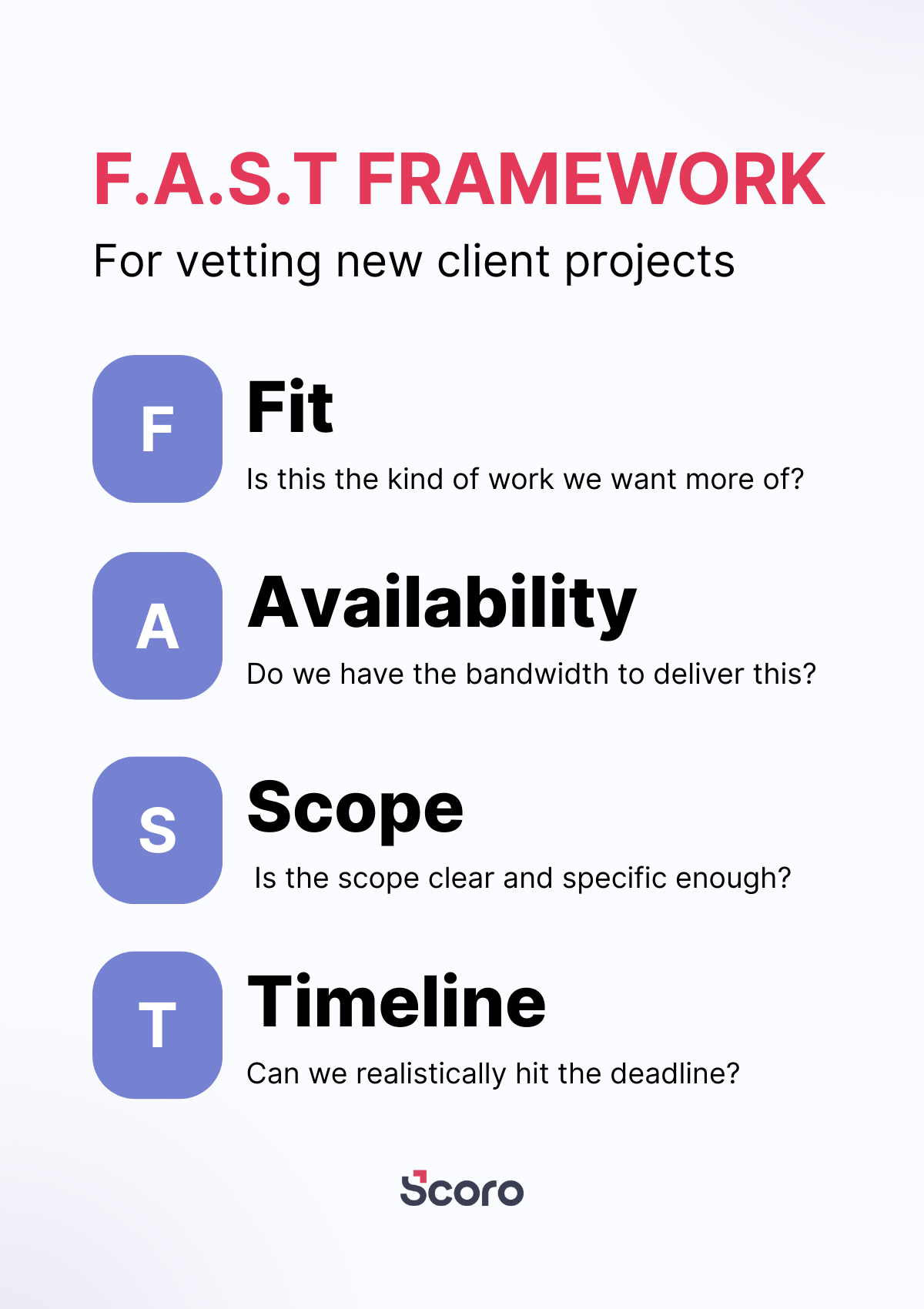
Instead of making decisions based on gut feelings, F.A.S.T. gives you a consistent, objective way to evaluate opportunities during pipeline reviews and client discussions.
Now let’s break down each element and how to apply it in practice.
F – Fit: Is this the kind of client or work we want more of?
Fit is about whether a project moves your agency in the right direction.
Just because you can do the work doesn’t mean you should—especially if it pulls your team away from what they do best.
We get the temptation to always say “yes” to new projects and revenue. But misaligned work will cost you.
It forces your team to operate outside their expertise, makes your market positioning confusing (because prospects won’t know what you actually specialize in), and requires more hands-on management when the work doesn’t play to your team’s strengths.
Brandon Rollins, CEO and founder of Pangea Marketing Agency, learned this the hard way:
We’ve taken on low-fit projects before, and it almost always results in overwork for me (or worse, someone else on the team) to try to fit a scope that we shouldn’t have offered up.
On the other hand, projects that are the right fit will:
- Align with your team’s core strengths
- Involve clients who understand and value your expertise
- Deliver stronger profit margins
- Help you build a strong reputation
The point is: don’t force it. New clients and projects should feel like a natural extension of your existing capabilities, not total pivots just for the sake of a paycheck.
Scoro’s “Project list” view gives you an real-time overview of project KPIs, including profit margins, labor costs, and client types.
For example, you can see below that the “Rebranding project for Asher had an 81.60% profit margin. And the “Time and Material Project” had a negative margin of -37.34%:
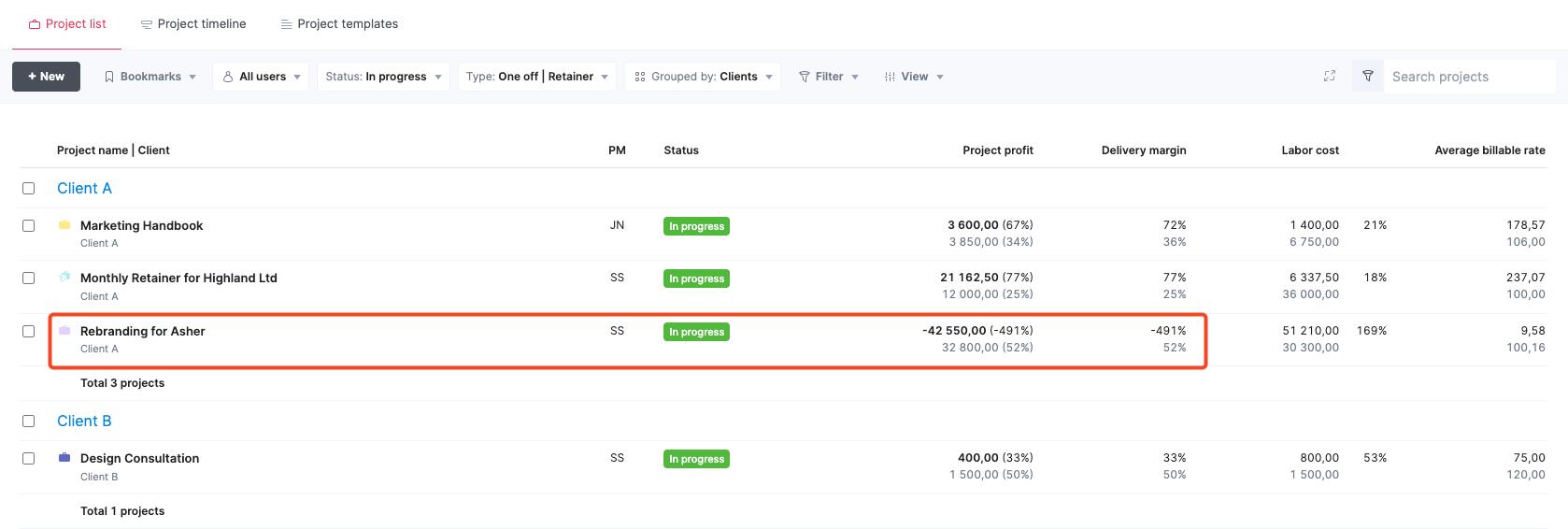
Toggle between different “Filter” and “Data columns” options to spot patterns. For example, which client types consistently deliver 60%+ margins?
But also think beyond the numbers: which types of projects run smoothly, get renewed, or generate referrals? Use these insights to build a clearer picture of your ideal client profile. Then, evaluate new opportunities against these proven patterns.
A – Availability: Do we have the right people and bandwidth to deliver this?
Availability means having the right expertise, experience level, and schedule openings to deliver quality work without causing more problems than the project is worth.
- Expertise: If your team’s skillsets don’t align with incoming work, it causes quality issues and longer delivery times.
- Experience: Mismatched experience levels—whether senior people on junior tasks or junior people on complex work—either creates cost inefficiencies or performance problems.
- Bandwidth: Accepting projects when schedules are already packed results in burnout, rushed work, and missed deadlines.
For example, creative agency Design de Plume used to assign projects based solely on who was available rather than who was best suited for the work. But this approach led to skill mismatches and uneven workloads.
Now, with Scoro, they allocate work based on both availability and expertise—and improved profitability by 20%.
The “Bookings” module in Scoro uses a color-coded heatmap so you can see team capacity at a glance:
- Green: This person has availability
- Red: This person is overbooked
- Purple: This person has extra availability
- White: This person is off that day
This visual chart makes it easy to spot when someone like Eve is running at 125% capacity in September while Dave is only at 76%—so you can quickly reschedule or redistribute tasks.
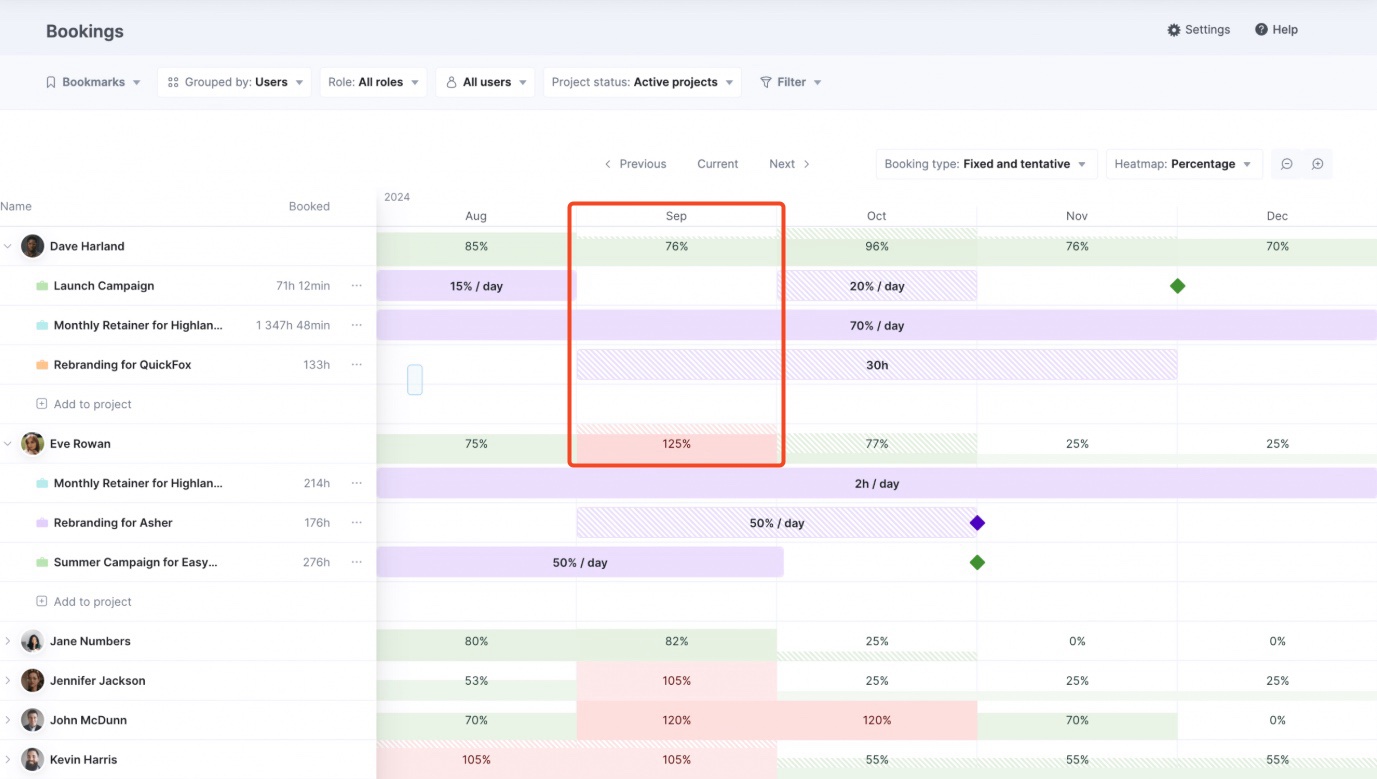
Use tentative bookings (striped background) to reserve time for potential projects while you’re still in discussions, then convert them to fixed bookings (solid background) once the work is confirmed.
So you can plan realistic timelines without double-booking your best people or leaving gaps in your schedule.
Further reading: Resource Planning For Multiple Projects
S – Scope: Is the scope clear and specific enough?
A clear project scope is the difference between a profitable project and one that kills your margins.
When deliverables or timelines are vague, you’re essentially agreeing to work without knowing what “done” looks like.
Sara Green-Hamann, founder of Tallwood HR Consulting, cites this as a major red flag:
A vague scope is a dead giveaway. Often, these clients are never satisfied because they don’t know what their end goal is.
Before moving forward with a prospect, make sure you have a:
- A clear deliverables list
- Measurable success criteria (like “increase website traffic by 10%” or “deliver three blog posts per week”)
- A single decision-maker with approval authority
If you can’t check all three boxes, pause the sales process and work with the client to clarify these details before moving forward. Don’t start work hoping things will become clearer later—they rarely do.
If you can’t nail down the scope in further discussions, consider turning the project down
Start every project with a detailed quote in Scoro before work begins. Break down services, deliverables, and roles—with clear pricing for each component.
Like this:
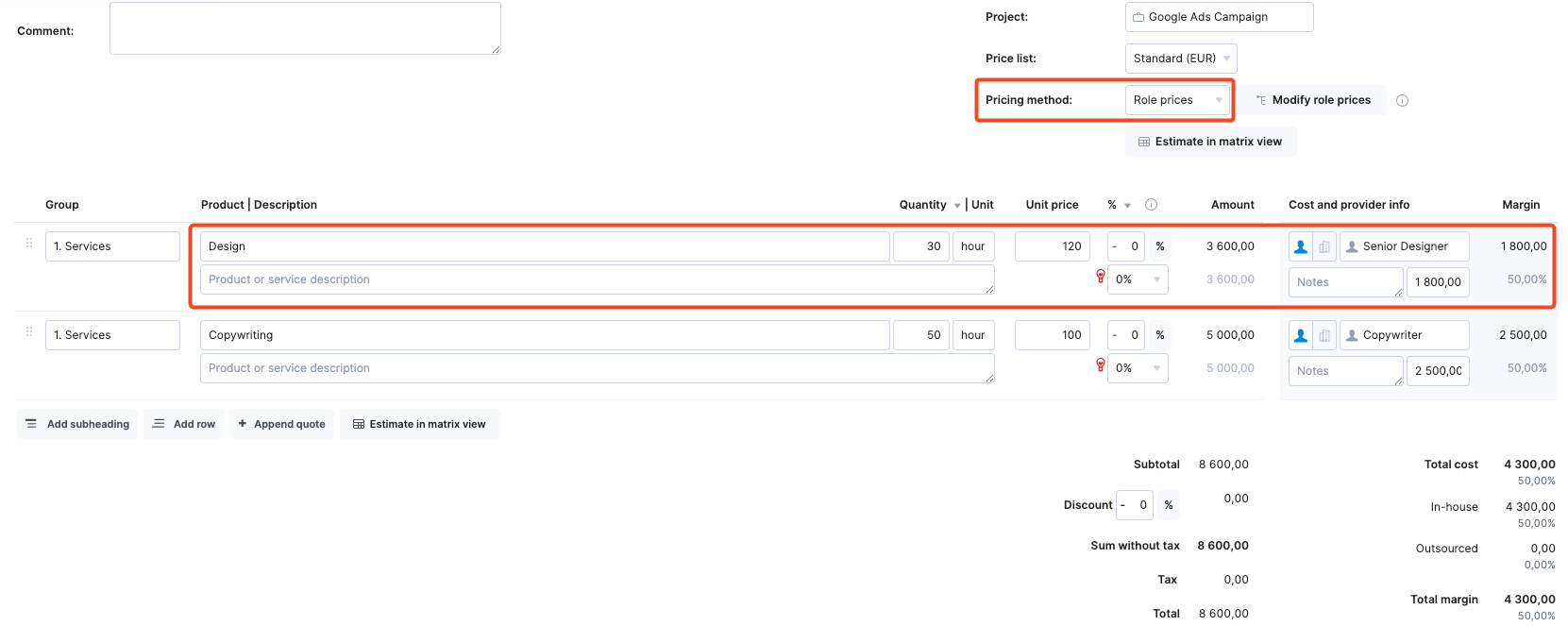
If your projects require multiple contributors per deliverable, Scoro’s matrix-style quoting makes it easy to assign several users to one line item and capture true delivery costs.
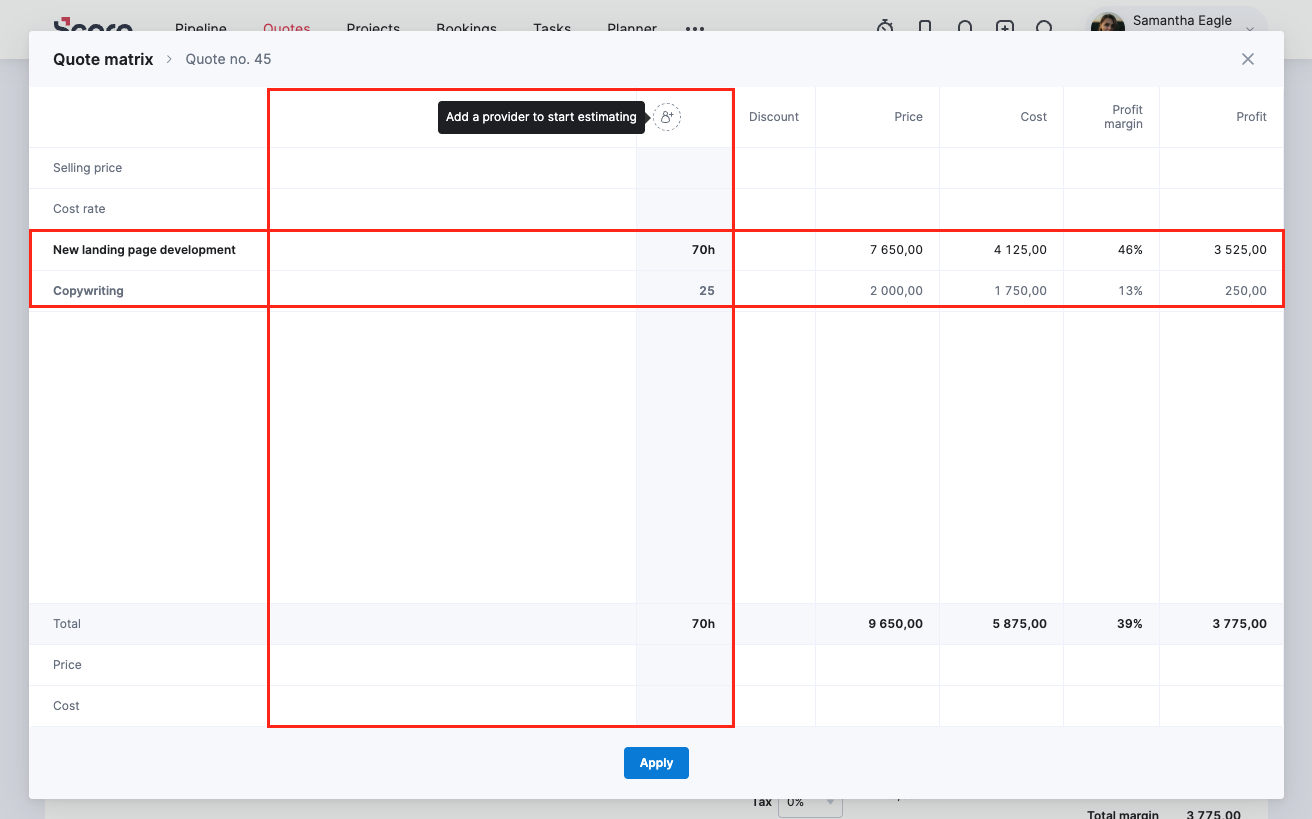
The quote then becomes your scope foundation. If a client requests changes later, you can point back to the original agreement and adjust pricing. Rather than absorbing extra work for free.
TIP: Save time and keep project data accurate by linking the quote to an existing project or converting it into a new project once approved. This helps you maintain updated financial and project reports and flag scope creep before it impacts your margins.
T – Timeline: Can we realistically hit our deadline without overscheduling?
Unrealistic timelines create a domino effect across your entire portfolio.
When teams rush to meet impossible deadlines, quality suffers, costs increase (from overtime pay, rework, and pulling expensive senior staff off other projects), and other projects get delayed.
Timeline pressure often happens due to overlapping priorities and poor resource scheduling. But sometimes, it’s a lack of ownership causing the timeline issue.
Jamilyn Trainor, senior project manager at trade show agency Müller Expo, remembers it well:
We once took on a project with an aggressive timeline but no defined client contact. Weeks later we were chasing approvals and redesigning work to match shifting expectations. The margin disappeared—and so did our team’s morale.
The lesson?
Push back on unrealistic expectations upfront, before your team is stuck scrambling to make up for them later.
Robin Dimond from Fifth & Cor recommends:
We provide options for them and go through what each option and proposed timeline looks like to match their budget and needs. Being super transparent up front creates long-lasting relationships with healthy expectations.
Robin recommends setting clear responsibilities for each project phase: “Each side has an outline for what they’re responsible for in days 1-30, then 31-60, 61-90, and so on.”
Use Scoro’s “Project timeline” view to spot overlapping deadlines, project phases, and potential resource conflicts before they become bigger problems:
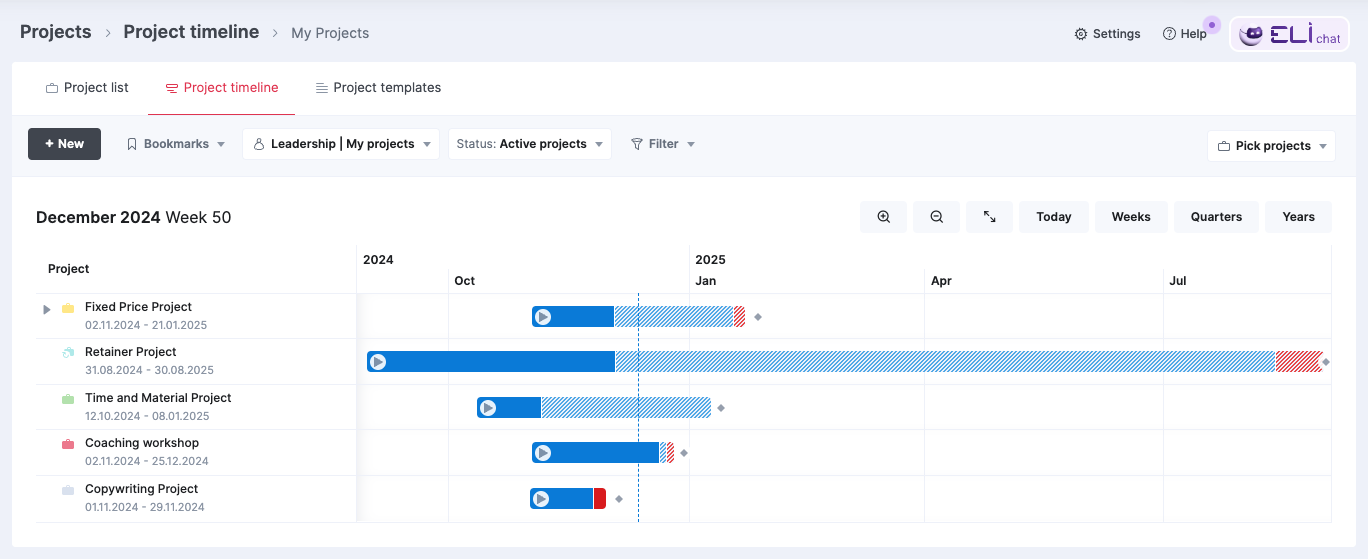
And use tentative bookings to see the best options for assigning work—without overcommitting your team.
In the example below, John is heavily overbooked in October and November, hitting 130% utilization.
So you would need to either assign the work to another designer (like Peter, who has a utilization rate of 25%), push back the project timeline, or consider hiring new staff.
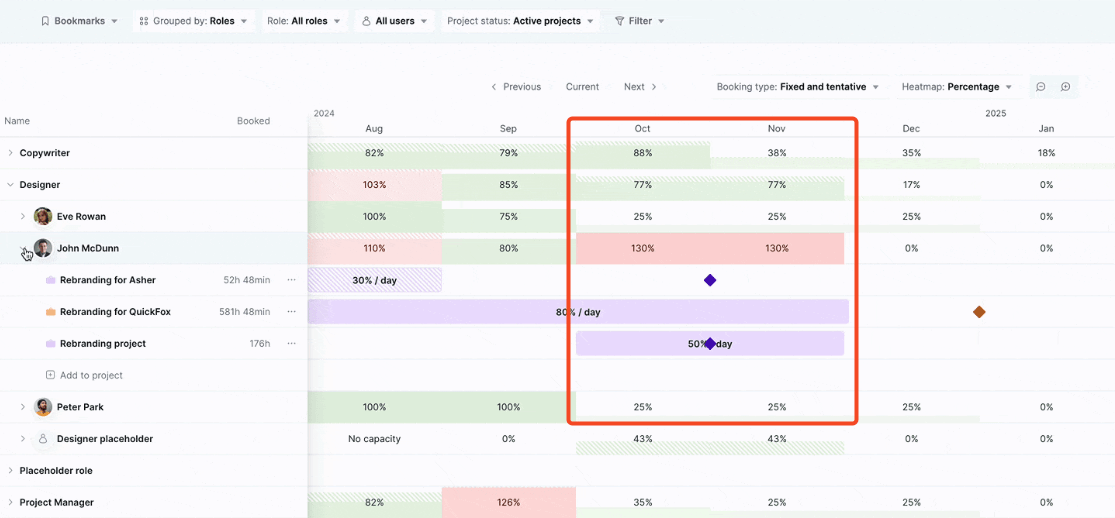
Putting F.A.S.T Into Action
The F.A.S.T. framework only works if your team actually uses it consistently.
Start by rating each project across all four criteria:
- 3 = Strong confidence, no concerns
- 2 = Some uncertainty, needs discussion
- 1 = Major risk, red flag
Then, total the scores:
- 10–12 points = Green light → Move forward confidently
- 7–9 points = Yellow light → Talk to the client to address potential issues
- 6 or below = Red light → Re-scope, delay, or decline
Here’s how it looks in practice:
A new website redesign project comes up in your pipeline review. You run it through F.A.S.T.:
- Fit = 3 → Right in your wheelhouse (10+ similar projects in this industry).
- Availability = 2 → The right people, but design is already at 90% utilization next month.
- Scope = 1 → Client only says they want “a fresh look” with no clear deliverables.
- Timeline = 2 → Aggressive, but doable if priorities are shuffled.
Total score = 8 → Yellow light.
What happens next?
- Sales pauses before sending the proposal
- Delivery schedules a scope workshop with the client
- After clarifying deliverables, Scope moves from 1 → 3, raising the score to 10
Now the project is a green light. And far less likely to blow up margins later.
With Scoro, you can add a custom F.A.S.T. score field directly into your pipeline view. This makes the score visible next to every quote, so your team can:
- Spot red/yellow flags early before committing resources
- Prioritize high-fit, profitable opportunities instead of chasing everything
- Keep sales and delivery aligned by making trade-offs visible at a glance
Over time, you can also review past scores against actual project outcomes (like margins or client renewals) to refine what a “green light” really looks like for your firm.
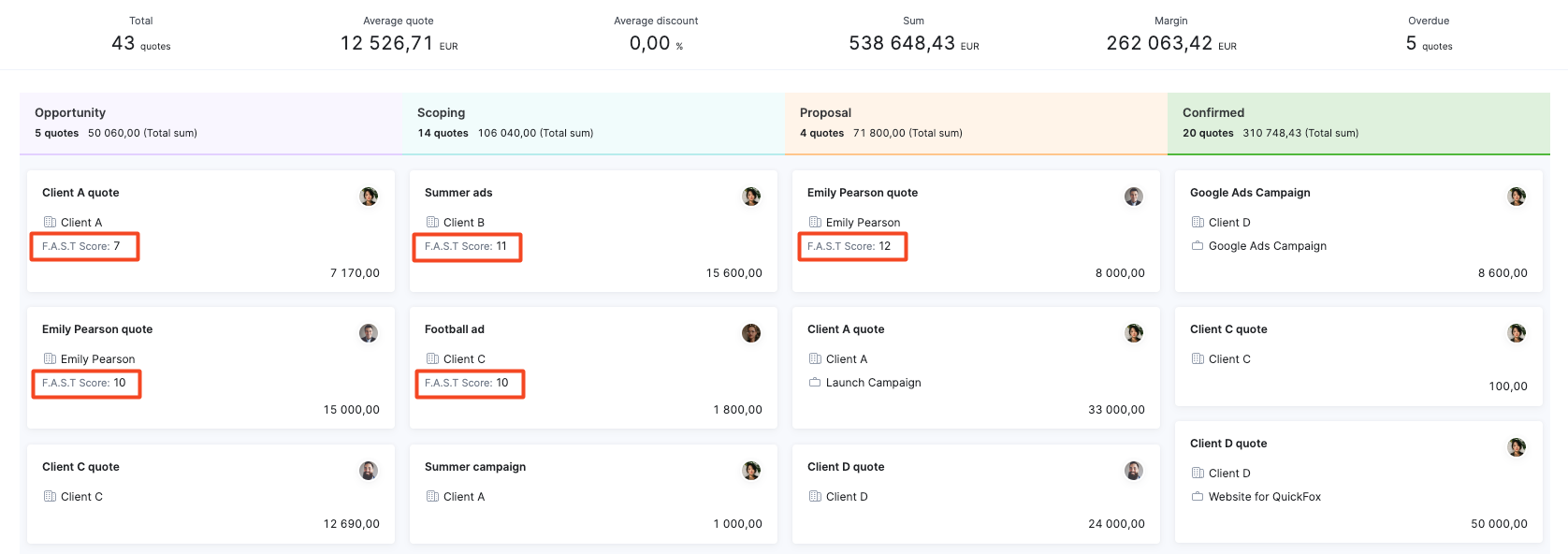
Say no to poor-fit projects before committing
Vetting opportunities protects your delivery team and your profits. Every misaligned project you turn down creates space for better work that actually moves your business forward.
The F.A.S.T. framework works best when you apply it consistently across all opportunities. Not just when deals feel risky. Make it part of your standard processes and watch how it transforms morale, efficiency, and profitability.
Want to go deeper on building a healthier sales pipeline? Check out these guides next:






